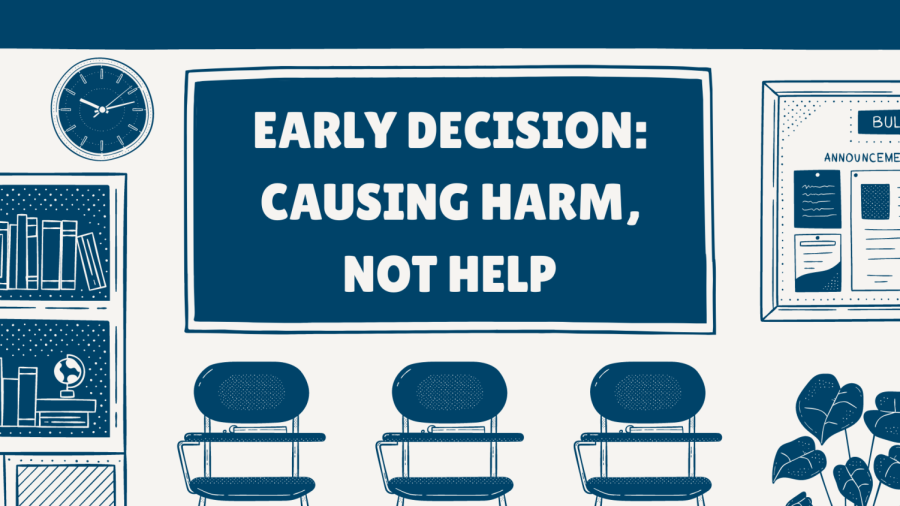Early decision: causing harm, not help
Mar 1, 2023
This previously ran in our February 2023 print issue.
With a pool of over 4,000 higher education schools, the expectation to commit to a “dream school” in the fall of one’s senior year can be stressful, limiting, and frankly, unnecessary.
Every year, around 60% of high school students take their first steps in enrolling in a college, according to the U.S. Bureau of Labor Statistics. Each student will be asked how they are applying and the primary options are regular decision, rolling admission, early action, and early decision.
Typically, regular decision deadlines are between January and February, with the admission results released between March and April; rolling admission deadlines vary, with the admission released four to six weeks after application; early action and early decision deadlines are in November, with the admission decision released in December. Around 450 schools in the U.S. offer early decision.
Early action and early decision both require the student to apply earlier than other application types, with the bonus of finding out admission status sooner as well. Early action is non-binding, therefore when the student finds out if they are admitted, they are not required to attend. Early decision is binding, so upon applying, the applicant must sign a contract saying they will attend the university if admitted and will withdraw all other applications even if they do not know admission status of those other schools — which they likely will not.
For most institutions, applicants have a higher chance of admittance when applying early action, and especially early decision, rather than regular decision. Colleges regard students applying early as more driven and committed than those applying regularly.
From a financial aspect, early decision serves as a disadvantage to students in need of financial aid and scholarship money, as they are committing to the school and accepting that they will not know the financial aid package upon applying. According to a 2016 National Association for College Admittance Counseling report, 87% of students are satisfied with their financial aid when applying early decision. However, it still eliminates the opportunity to negotiate packages with other schools, forcing students to take whatever their school is offering.
Applicants relying on financial aid have to roll the dice when it comes to early decision. Yes, there is a higher chance of admittance, but is it worth potentially losing the chance to leave college with less debt?
An exception to the binding agreement — depending on the school — would be if the student is not satisfied with their financial aid to the point where they cannot afford the school. However, some schools might not release financial aid awards by the time the student has to make the decision and students will have less time to turn it around and apply elsewhere if the package does not meet their needs.
If students are relying on a merit-based scholarship, they are at an even higher disadvantage. Merit-based scholarships are used to incentivize students to attend. If the student is already committed without seeing their financial packages and awards, there is no reason for the school to award them any, decreasing the likelihood of the student receiving one, according to the LendingTree, an online loan marketplace.
On the other hand, students who do not need to worry about financial aid are free to apply early decision without a second thought about whether or not they can afford the school, giving them an extra edge.
Asking a 17-or 18-year-old to decide where they want to spend the next four or more years of their life when most change what they want their future to look like once or twice a week can constitute as insanity.
If a student wants to back out without a reason deemed valid by the institution, it can hurt their odds of getting into another college, decrease the chances of other students from their high school getting into that college, and blacklist them from ever attending that school, even for graduate programs, according to College Covered, a website providing tools for researching how to get accepted into and finance college.
The requirement to make this decision so early also adds to the pressure. Not only are applications for early decision months earlier than regular decision, leaving the applicant less time to perfect the fine details, but with decisions not coming out until mid-December, unexpected denials will leave students scrambling for two weeks to meet the common Jan. 1 deadline for regular decisions.
The stress to apply early decision comes from knowing other students will also be applying early decision and will have a higher chance of getting in doing so. Decisions should be made on the best applicants, not just who can apply and commit all of their energy to a singular school a year before attendance. If students want the extra edge, that’s where early action comes into play.
The college application process is already hectic and stressful, as kids are deciding the where and what of the rest of their lives. Perpetuating the idea that kids should have a “dream school” by the beginning of their senior year is both unreasonable and toxic. For students that have a “dream school,” applying early decision and not getting accepted can turn their whole world upside down, especially if they see no other options as even comparable. For students that do not have a dream school, there lies the fear that not applying early decision to a school will result in not getting any of their top choices.
It is excessive and frankly unnecessary to set the expectation to make important decisions in such a short amount of time, when early action provides the same opportunity, with less pressure. College is simply a place to learn. Let’s stop pretending it’s life-or-death.












